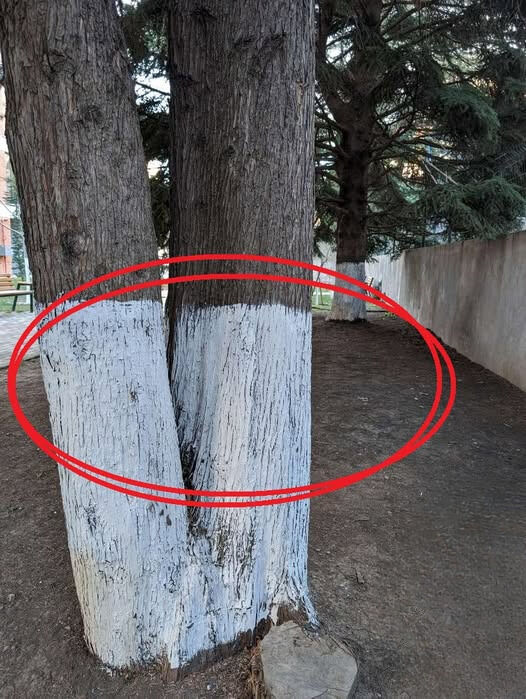For most of my life, I passed by trees with their lower trunks coated in white and never questioned it. Whether driving through rural farmland, strolling past an orchard, or walking through a city park, those bright white rings always seemed more decorative than functional. I assumed the practice was rooted in tradition, or perhaps it was something landscapers did simply because previous generations had done the same. The truth was, I never imagined that the paint served a real, practical purpose.
That changed when I happened to speak with a local arborist who had spent decades caring for young trees in our region’s unpredictable winters. He explained that this simple white coating—something most people overlook entirely—can actually play a critical role in protecting trees from one of winter’s most damaging and least understood threats. It’s an old practice, yes, but one backed by science, history, and generations of agricultural experience.
If you’ve ever wondered why people go out of their way to paint the lower section of a tree’s trunk, you’re certainly not alone. The surprising truth is that the reasoning behind it has nothing to do with decoration or tradition for tradition’s sake. It’s a form of protection—one that, once you understand it, becomes so logical that you may wonder how you didn’t notice its importance sooner.
Not All Tree Markings Communicate the Same Message
Many people are familiar with seeing various colored markings on trees. Orange often means a tree is slated for removal. Blue marks typically relate to surveying boundaries or utility indications. Purple paint is commonly used in certain regions to mark private property or areas where trespassing is prohibited. These are messages intended for people—clear signals meant to communicate ownership, boundaries, decisions, or warnings.
White paint, however, is different. It isn’t placed there as a symbol or instruction. It isn’t meant to convey a message to passersby. Instead, it performs a silent job on behalf of the tree itself. It’s not symbolic but functional. And understanding that function starts with recognizing that winter—contrary to what many assume—brings more challenges to trees than simply cold temperatures.
The Real Winter Threat: Not the Cold, but the Rapid Temperature Swings
Most people know that winter is stressful for trees, but far fewer understand why. After all, trees survive outdoors year-round. Their roots anchor them through storms and snow. Their trunks endure wind, rain, and frost. Many assume that because trees seem so rugged and permanent, they can easily handle whatever nature throws at them.
But young trees, especially those with still-developing bark, are far more vulnerable than they appear. And the biggest danger they face isn’t freezing—it’s sudden temperature fluctuation.
On bright winter days, even when the air remains cold, the sun can shine directly onto the south or southwest side of a tree’s trunk. This sunlight warms the bark far more than most people realize. Even while the surrounding air stays chilly, the tree’s exposed surface absorbs heat and expands ever so slightly. Then, as evening arrives, the temperature plunges rapidly. That same warmed bark cools down much too quickly.
This rapid warm-cold cycle forces the bark to expand and contract within a short period of time—sometimes within minutes—and that dramatic shift can cause the bark to split open. These long, vertical cracks are known as sunscald injuries. The damage often starts superficially, looking harmless at first glance, but over time these splits deepen. Insects, bacteria, and fungi can enter through these cracks, often leading to infections or decay that weaken the tree and potentially threaten its long-term survival.
Sunscald is worst in:
- Young trees with thin bark
- Fruit trees, which are especially susceptible
- Trees planted in open areas where the winter sun hits unobstructed
- Urban trees exposed to reflective surfaces like buildings, glass, or pavement
What makes sunscald particularly dangerous is that its effects may not be fully visible until months later—sometimes even a full season. By the time the damage becomes obvious, the tree may already be struggling internally.
How White Paint Protects a Tree From Sunscald
This is where the white paint earns its importance.
White reflects sunlight. It keeps the bark from absorbing too much heat during the day. With less heat entering the bark, there’s less dramatic cooling at night. That means the bark stays closer to the ambient temperature and doesn’t endure the rapid expansion–contraction cycle that leads to cracking.
In simpler terms:
White paint prevents the trunk from overheating in winter sunlight, which prevents it from cooling too fast at night, which prevents cracks from forming.
It’s the tree version of sunscreen—protective, preventative, and incredibly effective despite its simplicity.
Because of this protective effect, orchard managers, farmers, landscapers, and arborists have used this method for generations. Even in modern agricultural practices, where technology and scientific advancements influence nearly every stage of plant care, painting tree trunks remains a recommended best practice in many climates.
Why the Paint Must Be Chosen Carefully
While the concept is straightforward, not just any paint should be used. Tree-safe white latex paint—specifically non-toxic and water-based—has become the widely accepted standard. And even then, the paint must be diluted. A mix that is roughly 50 percent paint and 50 percent water allows the coating to remain breathable. Trees, despite their tough exterior, must release and absorb moisture through their bark. Too thick a paint layer creates a sealed surface that traps moisture, potentially suffocating the tree or encouraging fungal growth. Too thin a layer won’t reflect enough sunlight to offer meaningful protection.
Applying the paint correctly matters. Gardeners typically use a wide brush to spread the mixture smoothly around the trunk, usually coating the lower two to three feet—the area most exposed to direct winter sunlight. In large orchards, where hundreds of trees may need treatment, workers sometimes use sprayers to apply it quickly and evenly.
Once dried, the paint acts like a shield for the rest of the winter, helping to keep the tree’s temperature stable during the day-night cycle. Most trees require just one application each winter season, although those in severe climates with repeated storms may need touch-ups.
Young Trees Are Particularly Vulnerable
Many people think of trees as self-reliant organisms that can survive almost anything. And while older trees are indeed remarkably resilient, young trees—especially newly planted ones—are far more fragile. Their bark hasn’t thickened yet. Their root systems are shallow and still expanding. Their internal systems haven’t fully developed the ability to regulate temperature changes as effectively as mature trees can.
Even a single harsh winter can stunt a young tree’s growth or inflict damage that becomes visible only years later. Sunscald doesn’t always kill a tree outright, but it often compromises its structure, weakens its defenses, and makes it more susceptible to pests and diseases.
A thin, inexpensive coat of white paint significantly improves a young tree’s chance of surviving its early years, especially in regions with unpredictable winters or fluctuating temperatures.
Painted Trunks Help Urban Trees Too
It’s not only rural or agricultural environments where this practice matters. Urban trees often face even more dramatic temperature variations. Pavement, concrete, brick, and glass create unusual heat patterns. Sidewalks soak up sunlight during the day and release it at night. Tall buildings cast shadows, then redirect sunlight unexpectedly. Car engines and winter street treatments add even more variables.
All of these factors can create exaggerated warm-cold swings that stress city trees. A painted trunk helps buffer those shifts and gives the tree a better chance of adjusting without experiencing injury.
Addressing Common Misconceptions About Tree Painting
Some people worry that the paint is harmful. Others believe it’s purely aesthetic or part of a tradition with no real purpose. But modern tree-safe latex paint, when diluted correctly, poses no danger to the tree. In fact, arborists often recommend it as one of the simplest and most effective preventative measures available for young or thin-barked trees.
Here are a few additional misconceptions:
“The paint prevents pests.”
In some countries and regions, the paint does help deter certain insects, but in many climates its primary purpose is temperature regulation.
“Painting trees is outdated.”
While it’s old, it’s not outdated. Many agricultural guides, university extension programs, and horticultural experts still recommend the practice today.
“It looks unnatural.”
To an untrained eye, it might. But once you understand the reasoning, painted trunks become a sign of care rather than decoration.
“Only orchards do this.”
This technique is used in orchards, yes, but also in private gardens, public parks, vineyards, nurseries, and urban areas around the world.
A Tradition Rooted in Global History
Painting tree trunks white isn’t only an American or European practice. It appears across Asia, the Middle East, Latin America, and parts of Eastern Europe. Different cultures adopted it for different reasons:
- Protection from winter sunscald
- Visible markings to help prevent nighttime collisions
- Discouraging insects or grazing animals
- Reflecting heat in extremely sunny climates
Despite the variety of regional uses, the underlying principle remains the same: white paint helps protect vulnerable parts of the tree from environmental stress.
Seeing Painted Trees With New Understanding
After learning the science behind the practice, I began noticing white-painted tree trunks differently. What once seemed random or merely ornamental suddenly felt intentional and thoughtful. Someone had taken the time to ensure the tree had a chance to survive a harsh winter. Someone cared enough to provide a little extra support to an organism that couldn’t ask for help on its own.
Trees may be strong, but they aren’t invincible. Even the most resilient species need assistance when young, especially in climates with unpredictable winters. A single layer of white paint can help prevent damage long before spring arrives. It can mean the difference between a tree that grows, thrives, and matures—and one that suffers injuries that shorten its lifespan.
The next time you walk past a tree with a white-painted trunk, you’ll know there’s more to it than meets the eye. That coat of paint isn’t cosmetic; it’s a protective barrier, a small act of care that supports the tree through the most challenging season of its life.
In a world where so many of our interactions with nature are unintentional or rushed, there’s something beautiful about an old practice that remains effective, simple, and deeply rooted in the desire to help something grow.



